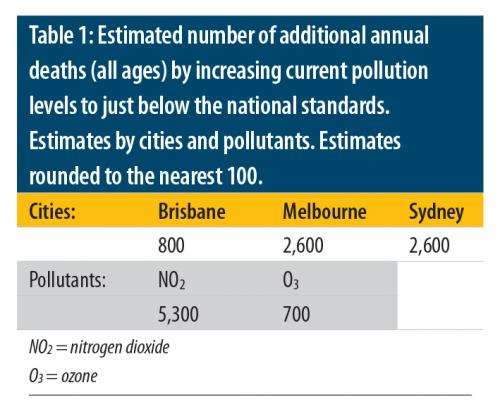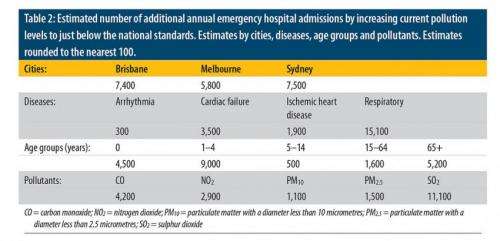Expect 6,000 more Australian deaths if pollution rises to 'safe' threshold

The National Environment Protection Measures (NEPM) has set maximum daily limits, or 'standards', for six key outdoor pollutants, which QUT's Associate Professor Adrian Barnett says many authorities wrongly assume to be 'safe' thresholds for health.
To test that assumption, Professor Barnett calculated what the health effects would be if the current average levels of five of those pollutants across Melbourne, Sydney and Brisbane were to rise to just below the NEPM 'safe' standards.
"I've found that increasing pollution levels to just below the NEPM standards would cause the deaths of an extra 6000 people each year - 2,600 in both Melbourne and Sydney and 800 in Brisbane," said Professor Barnett, a health statistician with the Institute of Health and Biomedical Innovation.
"The increase would hospitalise a further 20,700 people per year across those cities.
"Study after study has shown there simply is no safe level of air pollution – health problems in the population rise in line with increases in average pollution levels.
"It's understandable that the public could misinterpret the NEPM standards to mean anything below those levels is safe – but it's inexcusable for authorities to use this safe-or-dangerous interpretation.
"I have lost count of the number of government-commissioned environmental reports that have used this fallacy. This practice should have ended years ago."
In a commentary published in the Australian and New Zealand Journal of Public Health, Professor Barnett cited recent environmental reports for the East–West road link in Melbourne and trains carrying coal in Queensland concluding that predicted pollution increases were 'safe' levels.

"Locals concerned about the potential health effects have found it difficult to get past the argument that the increases are below the standards and therefore everything is fine," he said.
"But any new project that increases air pollution will always mean an increase in illness."
Professor Barnett is calling on Australian authorities to instead use thorough cost-benefit analyses of increased pollution levels in future environmental studies.
He said the increased health problems could then be balanced against the economic and societal benefit of the new infrastructure or industry.
"Such cost-benefit analyses are not difficult to do and they will allow policy makers to make better-informed decisions based on the merits and costs of the project," Professor Barnett said.
"Changes also need to be made to the National Environment Protection Measures (NEPM) documentation and web site to prominently state that the standards should not be used to judge whether individual projects are safe or dangerous."
The health statistician has also recommended authorities better communicate the risks of air pollution to the public, including stating the estimated health impacts of existing pollution level categories.
"For example, the Victorian Environmental Protection Agency (EPA) gives hourly updates on air quality for 16 sites across the state," Professor Barnett said.
"This was clear during the recent fire at Morwell where the particulate matter numbers peaked at over 550 µg/m3.
"To help interpret the numbers, the Victorian EPA has categorised and colour-coded the results into five categories from "very good" to "very poor".
"However, these categories still do not have enough meaning for lay people, particularly when people want to know if they should change their behaviour in order to reduce their exposure."
Professor Barnett's analysis of death rates in Morwell following the 45-day Hazelwood coal fire revealed the resulting pollution caused an estimated 15 per cent increase in the local death rate, which translates to 11 to 14 premature deaths.
The World Health Organization has estimated outdoor air pollution causes 3.7 million deaths every year, 3000 of those in Australia.
More information: onlinelibrary.wiley.com/journa … 1111/(ISSN)1753-6405














